Do you have a question about the Hitachi RAK-18QH8SW and is the answer not in the manual?
Instructions for operating the air conditioner.
Detailed diagrams of the indoor unit's physical structure and dimensions.
Identification and specifications of key internal components like thermostat and fan motor.
Schematic showing electrical connections within the indoor unit.
Detailed electrical schematic for the remote control unit.
Overview of the indoor unit's functional blocks and their interconnections.
Explains the fundamental operating modes and their control logic.
Illustrates the refrigerant flow for cooling, dehumidifying, and heating operations.
Details on how the auto swing feature operates under different conditions.
Explanation of the indoor unit's power and control circuit operations.
Guidelines for handling and protecting semiconductor components from damage.
Detailed component specifications, including presence of protector, switches, and thermostat.
Highlights new refrigerant R410A and synthetic ester oil, and associated new technology.
Details on piping thickness, flare expansion, and nut dimensions for R410A.
Lists new tools required for R410A refrigerant handling and their differences from HCFC-22 tools.
Instructions for setting the unit's capacity between 1.8kW and 1.2kW.
Identification and description of major indoor unit components like filters, panels, and indicators.
Details the buttons, display, and functions of the remote control unit.
Explains Auto Restart Control and Automatic Operation modes of the air conditioner.
Guide on how to operate the unit for heating, including fan speed and temperature settings.
Instructions for operating the unit in dehumidifying mode, including temperature and fan speed.
Guide on how to operate the unit for cooling, including fan speed and temperature settings.
Instructions for using the unit as a fan for air circulation.
Steps for setting the OFF-timer, ON-timer, and ON/OFF-timer functions.
Guide on setting the sleep timer function for automatic adjustment of temperature.
Process for adjusting shift values on the remote control for fine-tuning operation.
Instructions for replacing batteries in the remote controller.
Recommendations for optimal room temperature settings for comfort and energy saving.
Tips on using curtains or blinds to manage heat entering the room.
Advice on maintaining adequate ventilation by occasionally opening doors and windows.
Guidance on using timer functions for comfortable room temperature control, especially at night.
Importance of regular air filter cleaning for efficient operation and energy saving.
Precautions for setting temperature and airflow for vulnerable individuals like babies and children.
How room heat sources can affect the air conditioner's ability to reach set temperatures.
Recommendation to switch off the power supply when the unit is not used for extended periods.
Safety advice to stop operation and unplug the unit during lightning storms.
Guidance on maintaining distance from electrical products to avoid noise interference.
Step-by-step instructions for installing the air cleansing filters into the unit.
Procedure for cleaning the air filter to maintain airflow and cooling efficiency.
Instructions for removing and cleaning the front panel of the indoor unit.
Steps for maintaining the unit before a long period of non-operation.
Checklist for qualified personnel to perform periodic inspections of the unit.
A guide to common issues and checks when requesting service for the air conditioner.
Specifications and connection details for Thermostat and Fan Motor components.
Schematic showing electrical connections within the indoor unit.
Detailed electrical schematic for the remote control unit.
Overview of the indoor unit's functional blocks and their interconnections.
Detailed timing chart and notes explaining the sequence and conditions of basic cooling operation.
Explanation of the sleep operation mode for cooling, including temperature and fan speed adjustments.
Details on the sleep operation mode for dehumidifying, including temperature and fan speed settings.
Detailed timing chart and notes explaining the sequence and conditions of basic heating operation.
Explanation of the defrosting process and inhibit periods during reversing valve operation.
Guide to the sleep operation mode for heating, including temperature and fan speed settings.
Description and timing chart for the reset circuit that initializes the microcomputer.
Explanation of the light receiver unit's function in processing wireless remote signals.
Details on the buzzer circuit that provides audible feedback during operation.
Explanation of the circuit controlling the indoor fan motor speed and rotation feedback.
Description of the circuit controlling the auto sweep motors for air deflectors.
Explanation of the circuit that measures room temperature and its voltage output.
Explanation of the circuit measuring heat exchanger temperature for various control functions.
Description of the circuit that reads initial settings from E2PROM for compressor and preheating values.
Guide to diagnosing issues based on timer lamp blinking patterns and possible causes.
Flowchart for diagnosing power issues and checking electrical components in the indoor unit.
Procedures for troubleshooting and verifying the functionality of the remote controller.
Illustrated diagram showing the location of various indoor unit parts with corresponding numbers.
| Star Rating | 3 Star |
|---|---|
| Cooling Capacity | 5100 W |
| Type | Split AC |
| Refrigerant | R32 |
| Power Supply | 50 Hz |
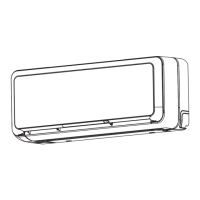

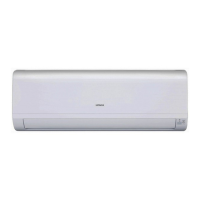
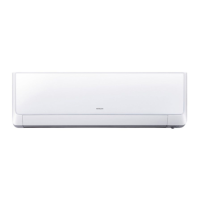
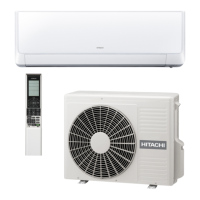



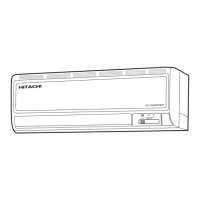


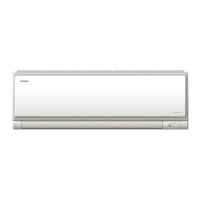
